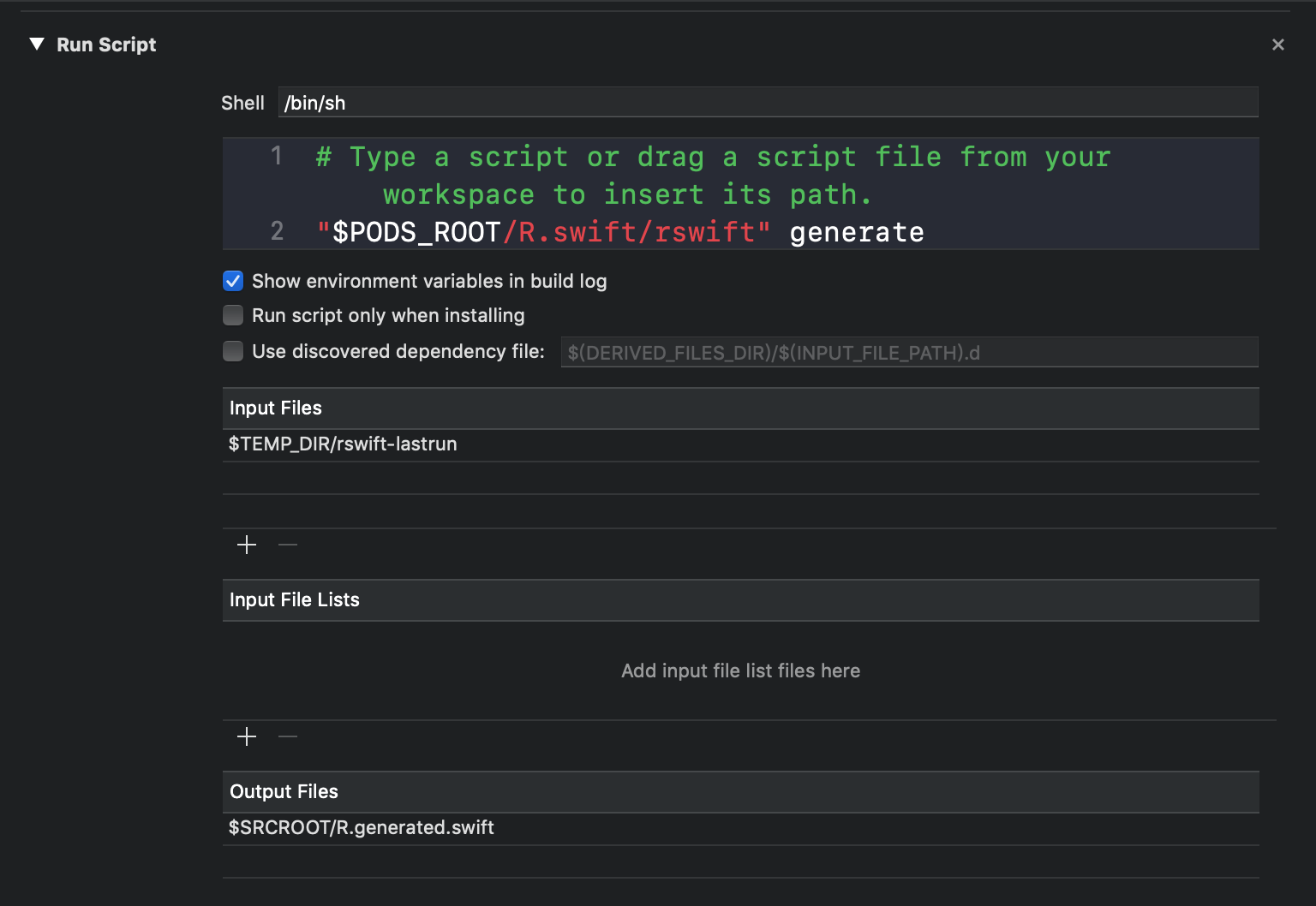在新的项目中,接触到了一个很不错的框架R.swift,可以帮助更方便安全的使用资源文件,相信已经使用过的或者还没有接触过的,一旦使用过了解过它,会爱上这个框架工具!
一、R.swift特点
- 当项目build之后,R.swift开始运行,也就是说添加完图片等资源文件时,build一下,R.swift第三方库就会设置好刚刚添加的资源.
- 加入的资源文件在build后自动在R.generated.swift文件中按照类型生成结构体.
- 强类型,不需要类型判断和转换,自动返回对应类型.
- 支持了多种资源类型.
- 避免了资源名称拼写错误.
二、安装
- 添加pod 'R.swift'到你的Podfile文件中,紧接着运行pod install
- 打开工程文件,点击工程文件名称,选择TARGETS,点击Build Phases,在点击左上角的“+”添加New Run Script Phas

3. 脚本输入"$PODS_ROOT/R.swift/rswift" generate "$SRCROOT/R.generated.swift",input files 添加 $TEMP_DIR/rswift-lastrun,out files 添加 $SRCROOT/R.generated.swift

4. 拖拽R.generated.swift文件到项目中.
三、具体使用
1. 图片-images
原生写法
let sIcon = UIImage(named: "settings-icon")
使用R.swift
func icon() -> UIImage? { switch self { case .sourceRegulator: return R.image.home_SourceRegulatory() case .regulation: return R.image.home_regulationIcon() case .broker: return R.image.home_brokerIcon() case .engine: return R.image.home_engineIcon() case .falseBroker: return R.image.home_falseBrokerIcon() case .spread: return R.image.home_spredIcon() } }
2. 文件-Files
原始写法
let plistURL = Bundle.main.url(forResource: "Book", withExtension: "plist") let jsonPath = Bundle.main.path(forResource: "data", ofType: "json")
使用R.swift后
let plistURL = R.file.bookPlist() let jsonPath = R.file.DataJson.path()
3.字体-Fonts
原始用法
let lightFontTitle = UIFont(name: "chalkduster", size: 22)
使用R.swift
R.font.chalkduster(size: 35)
4.Localized strings
原始写法
let welcomeMessage = NSLocalizedString("welcome.message", comment: "") let settingsTitle = NSLocalizedString("title", tableName: "Settings", comment: "") // Formatted strings let welcomeName = String(format: NSLocalizedString("welcome.withName", comment: ""), locale: NSLocale.current, "Alice") // Stringsdict files let progress = String(format: NSLocalizedString("copy.progress", comment: ""), locale: NSLocale.current, 4, 23)
使用R.swift
// Localized strings are grouped per table (.strings file) let welcomeMessage = R.string.localizable.welcomeMessage() let settingsTitle = R.string.settings.title() // Functions with parameters are generated for format strings let welcomeName = R.string.localizable.welcomeWithName("Alice") // Functions with named argument labels are generated for stringsdict keys let progress = R.string.localizable.copyProgress(completed: 4, total: 23)
上面就是本人项目经常使用到的,当然还有其他的用法和用处,不过,通过R.swift已经大大的方便我们日常开发,希望大家在项目中尽早的使用R.swift这个第三方库.